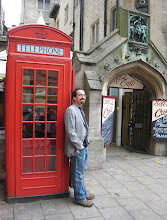
(The picture was made with a public domain plotting program called POV-Ray which is very easy to use. I highly recommend it. It is to most graphics programs what LaTeX is to word processing.)
First of all, my apologies to many of the people who showed up to listen to the talk and felt that they were snowed by the relatively mathematical content. I had the talk calibrated for the station Q audience (people who are not afraid of mathematical words like "modular tensor category" and "Dehn surgery") and I did not expect it to be so well attended by more general physicists from outside of Q. Then, once the talk was prepared and in motion, I didn't know how to make it more user-friendly on the fly. I felt really badly about this: I personally hate it when a speaker talks to only a small subset of their audience. I find it annoying and rude, and I frequently walk out of such talks. So I feel badly that I was certainly doing exactly that. I promise to try to construct a more accessible version of this talk for the future. I think it is a pretty cool topic once you cut through the formalism just a bit.
OK, now for a brief description of the talk. The above pretty picture is a geometric construction known as “Chain Mail” invented by Justin Roberts in the mid 1990s. The rough idea is to get information about the 3 dimensional manifold of space you are living in. You break the manifold of space into cells (cubes in the picture) and you wrap a string around each plaquette of each cell (These are the longer darker strings) then you tie the strings together with other strings (the shorter lighter strings). Now view all these strings as a complicated knot (or more properly a link, since it is a knot with many strands). Then you evaluate a property of the knot such as its Jones polynomial, Kauffman invariant or the like. The result is independent of the details of the decomposition of space and gives you information about the structure of your manifold. In fact, it gives you precisely the so-called Turaev-Viro invariant (A theorem by Turaev and Walker tells us that this is the square of a Chern-Simons partition function. The theorem is proved in about three lines using the chain-mail construction). It turns out that this construction can also be shown to be equivalent to the Levin-Wen construction of topological lattice models -- the chain mail picture is interpreted as a 2+1 dimensional space-time diagram. This is what my talk was about. This equivalence gives you a very physical understanding of why the Levin-Wen construction ends up giving you a doubled (achiral) theory. (This work is collaboration with Fiona Burnell, who has been mentioned several times on this blog).
I had posted earlier that I was afraid that Mike Freedman or Kevin Walker would find some hole in my argument. They did indeed manage to find an error in the argument, but it turns out to be very minor and easily fixable. I had some good discussions with both of them after the talk and this made me think that perhaps we really did have something interesting to say.

No comments:
Post a Comment